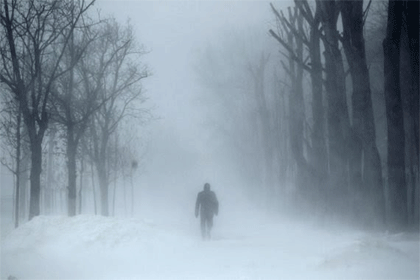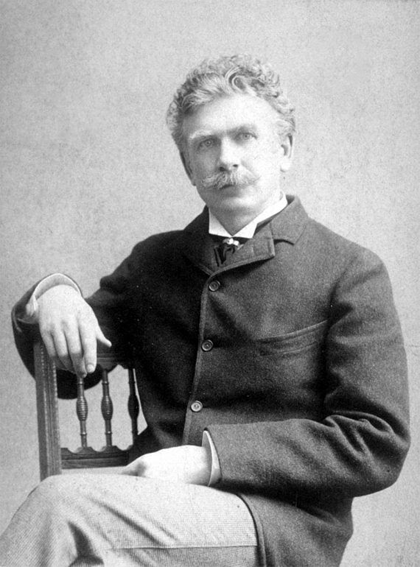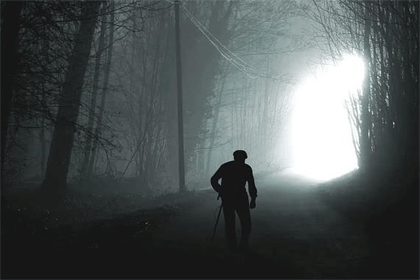
A Deconstruction of the Infamous Spontaneous Vanishing of David Lang
Brent Swancer July 13, 2021
The world of paranormal and Fortean literature is littered with all manner of strange and fantastical tales, and many of these have become mainstays that are written of again and again. Many will read such amazing tales and gasp with astonishment and believe these stories as being perhaps real, but there at times seem to be just as many bogus stories taken into the canon as those that are truly mysterious and warrant further research. The world of the strange is sadly peppered with questionable cases that have gone on to be embraced as real, and sometimes it is worth calling out a story that needs to be retired from the discussion. One account widely reported on that is most likely a pure fabrication is one of the most beloved stories of an anomalous vanishing out there, which is undoubtedly odd, but which is likely no more than a figment of the imagination.
One of the most well-known supposed mysterious disappearances to ever appear in Fortean literature is that of one David Lang, who was supposedly a farmer who lived on a rural property near Gallatin, Tennessee. For those who have never heard the tale, the story goes that on September 23, 1880, when Lang was strolling across a field near Gallatin, Tennessee, when he suddenly just blinked out of existence as his wife, children, and two men passing nearby in a buggy all looked on in disbelief, just ceasing to exist as if erased from reality in full view of all of these witnesses. When the whole area was checked, they could allegedly find no sign of where David had gone. Making things even weirder was a reported fifteen-foot diameter circle of yellowed, dead grass where David had disappeared, and faint ghostly voices heard by his children seven months later in the exact spot where he had vanished, which they claimed belonged to their father. Prolific paranormal author Frank Edwards would famously write the gold standard of this case in his book Stranger Than Fiction, saying of it:
David Lang had not taken more than half a dozen steps when he disappeared in full view of all those present. Mrs. Lang screamed. The children, too startled to realize what had happened, stood mutely. Instinctively, they all ran toward the spot where Lang had last been seen a few seconds before. Judge Peck and his companion, the Judge’s brother-in-law, scrambled out of their buggy and raced across the field. The five of them arrived on the spot of Lang’s disappearance almost simultaneously. There was not a tree, not a bush, not a hole to mar the surface. And not a single clue to indicate what had happened to David Lang.
The grownups searched the field around and around, and found nothing. Mrs. Lang became hysterical and had to be led screaming into the house. Meanwhile, neighbors had been altered by the frantic ringing of a huge bell that stood in the side yard, and they spread the alarm. By nightfall scores of people were on the scene, many of them with lanterns. They searched every foot of the field in which Lang had last been seen a few hours before. They stamped their feet on the dry hard sod in hope of detecting some hole into which he might have fallen — but they found none. David Lang was gone. He had vanished in full view of his wife, his two children, and the two men in the buggy. One second he was there, walking across the sunlit field, the next instant he was gone.
 The strange tale was supposedly a sensation at the time, later appearing in the July 1953 issue of Fate Magazine and being written about by Harold Wilkins in his book Strange Mysteries of Time and Space (1958), and both Wilkins and Edwards claimed that this was a real and true account of a very anomalous and strange event. It all seems like such an amazing story, and for years it was treated as a genuine case of unexplained phenomena, and still is, but over time it has become apparent that it probably never happened at all. Researchers who have investigated the case have found that there is absolutely no record of a Lang family in Gallatin, Tennessee at that time, no news reports from the era mentioning the case, and no missing person reports filed at the time for a David Lang, making it pretty odd. It has now gone on to mostly be thought that the fantastical story was a fiction created by the writer of the original Fate Magazine article that mentioned it, a man named Stuart Palmer, as a journalistic hoax. Palmer had claimed that he had heard the tale directly from Sarah Lang, the daughter of David Lang, and for the most part people accepted this as fact. The case of David Lang would go on to become a recurring case in any discussion on paranormal vanishings, and has become entrenched in the lore of Forteana, but how real was any of this? As it turns out, probably not very.
The strange tale was supposedly a sensation at the time, later appearing in the July 1953 issue of Fate Magazine and being written about by Harold Wilkins in his book Strange Mysteries of Time and Space (1958), and both Wilkins and Edwards claimed that this was a real and true account of a very anomalous and strange event. It all seems like such an amazing story, and for years it was treated as a genuine case of unexplained phenomena, and still is, but over time it has become apparent that it probably never happened at all. Researchers who have investigated the case have found that there is absolutely no record of a Lang family in Gallatin, Tennessee at that time, no news reports from the era mentioning the case, and no missing person reports filed at the time for a David Lang, making it pretty odd. It has now gone on to mostly be thought that the fantastical story was a fiction created by the writer of the original Fate Magazine article that mentioned it, a man named Stuart Palmer, as a journalistic hoax. Palmer had claimed that he had heard the tale directly from Sarah Lang, the daughter of David Lang, and for the most part people accepted this as fact. The case of David Lang would go on to become a recurring case in any discussion on paranormal vanishings, and has become entrenched in the lore of Forteana, but how real was any of this? As it turns out, probably not very.
It is thought that Palmer probably lifted the idea for the tale from a book by the enigmatic author Ambrose Bierce, specifically the short stories called The Difficulty of Crossing a Field, and likely elements of another story called Charles Ashmore’s Trail, both of which Bierce included in his 1893 collection of short stories Can Such Things Be?. For anyone not familiar with Ambrose Bierce, in the late 1800s he was one of the most popular writers around, a celebrated Civil War veteran who was also a journalist and prolific author who wrote not only books and short stories, but also a wide array of newspaper articles and essays, and he appeared in publications as varied as the New York Journal, the New York American, the San Francisco Chronicle, and Cosmopolitan. Such was his popularity at the time that he has served as the inspiration to many other notable authors, including the greats Jack London and Joaquin Miller. Although his works remain more obscure and hard to get in more modern times, he was once known very well-known, particularly on the West Coast of the United States and especially for his work concerning the world of the bizarre and the supernatural. Indeed, the author was rather obsessed with death and the paranormal, which is rather prominently featured in his stories, with many of them including ghosts and other strange occurrences. Much of his work was also known for its very realistic tone, a carry-over from Bierce’s experience as a journalist, which gave the stories a convincing weight that at times made people believe that his works of fiction were actually factual pieces.
While The Difficulty of Crossing a Field shares many beats with the Lang story, involving a farmer who similarly evaporates into thin air, perhaps the best-known example of this realism is Bierce’s short story Charles Ashmore’s Trail. The story is written as if it is a real account of something that actually happened, and concerns a young man named Charles Ashmore, who on a snowy November night in 1878 leaves his family’s farm house in Quincy Illinois to go get water from a nearby well. Charles does not return, and his concerned family go out to look for him. Since a fresh snow has just fallen, there are footprints clearly visible leading off towards the well, but they abruptly stop halfway there. Calls out into the icy dark remain unanswered. There is no sign of Charles anywhere, no further footprints, and no trace of him having fallen down in the snow. He has simply blinked out of existence. Nevertheless, thinking that the young man has somehow managed to reach the well and then fallen in, the father and older sister make their way to the well only to find a clean sheet of unbroken ice overlaying it. Making things even spookier yet is that 4 days later the mother goes to the well to collect water and can hear the unearthly, disembodied voice of her son calling out from thin air at the spot where the footprints had ended. This haunting, ghostly voice would continue to call out from the ether from time to time before eventually disappearing completely. It is another famous case often listed as genuine in Fortean literature, but which is no doubt a complete fabrication by Bierce, merely written in the style of a real account.
 Ambrose Bierce
Ambrose Bierce
This strange story might be very familiar to anyone with an interest in mysterious vanishings, as it has often made reappearances in different permutations as a real case, and has influenced many other strange accounts that are supposedly “real,” including David Lang. One such supposedly real case that stemmed from these tales is the case of Oliver Larch, sometimes called Oliver Lerch or Oliver Thomas, who similarly goes out to a well behind his house, this time on Christmas Eve and in Indiana, and also disappears into thin air, in this case after a strange bright flash of light. When the family go to investigate, they then notice that the boy’s tracks stop in the snow halfway to the well and his terrified voice can be heard shouting from the air “Help! It’s got me! It’s got me!” from somewhere in the air above them before silence. Often mentioned as a true story of the strange, this is almost certainly a spinoff the Ashmore story penned by Bierce. It also sounds very, very similar to the David Lang case and undoubtedly influenced the account, along with other tales, in particular The Difficulty Crossing a Field.
Although in Bierce’s story The Difficulty of Crossing a Field, the vanished man’s name is Williamson and the event happens in Alabama, almost every other detail is exactly the same. Bierce followed up on this story by claiming that he had interviewed experts such as a scientist named Dr. Maximilian Hern, who theorized that the vanishing was caused by a “void spot of universal ether,” which were speculated to be spots in the fabric of reality that lasted only a few second but destroyed all matter within them, vaporizing anything unlucky to wander into one. Bierce also said that he had interviewed other researchers who said it was caused by a magnetic field that had transported Lang to another dimension. It was all very convincing, but all fiction. Interestingly, Bierce always claimed that the story of Williamson itself was actually in fact true, and that he had written his own story to be based on it after hearing the tale as a child and being fascinated and inspired by it, but this was likely just his usual effort to make it all seem as realistic as possible. Bierce was known to not only write in an authoritative, convincing way, but also added to the whole air of realism in his stories by doing things such as providing supposed follow-up interviews with family and witnesses to the strange events, as well as investigations of the sites themselves. In fact, his short stories were often not presented as short fiction at all, but rather mistakenly put forth as real, journalistic accounts. This realism has caused some of his stories to be sourced as real events, which is a testament to Bierce’s skill at weaving tales that blur the line between fact and fiction.
Both the Oliver Larch and David Lang cases have been in different permutations persistently reported on as real events that actually occurred, and are often referenced as factual in many works on the strange and unexplained, yet they most likely have their origins in Bierce’s original fictional short stories, or were at least heavily influenced by them. This was the extent of his power to convince people that the situations in his fiction had really occurred, whether he did this intentionally or not. Although Bierce had a genuine interest in the paranormal, and unexplained vanishings in particular, and also wrote many of his stories in a way that made them seem as if they were based on real events, they were probably totally fabricated or at best fact mixed with good amounts of fiction, as many of his stories were known to be. It is often hard with Bierce’s work to tell where the line is between the real and the fantastical. This has caused many of his stories to be picked up as real disappearances that actually occurred, often changing slightly over the years, and muddying the waters for those looking for the genuine article with real sources, blurring the line between what is reliable information and what is not.
 Bierce’s work was often sourced in many other articles, journals, and books without anyone being none the wiser that it was all based on a source that was questionable at best and bogus at worst, but it would all snowball into the stories being taken as fact with little questioning. The fact that so many books on the paranormal and unexplained have frequently mentioned these stories that are based on fictional accounts does not bode well for the other myriad similar cases of people vanishing into thin air, and one wonders if a lot of these tales are similarly colored with fiction or even complete hogwash. With these strong indications of unexplained phenomena being treated as real based on fictional sources, it is hard with these bizarre accounts of spontaneous vanishings to separate what might have actually happened from what is pure fancy. At the very least some of these cases must be taken with a grain of salt.
Bierce’s work was often sourced in many other articles, journals, and books without anyone being none the wiser that it was all based on a source that was questionable at best and bogus at worst, but it would all snowball into the stories being taken as fact with little questioning. The fact that so many books on the paranormal and unexplained have frequently mentioned these stories that are based on fictional accounts does not bode well for the other myriad similar cases of people vanishing into thin air, and one wonders if a lot of these tales are similarly colored with fiction or even complete hogwash. With these strong indications of unexplained phenomena being treated as real based on fictional sources, it is hard with these bizarre accounts of spontaneous vanishings to separate what might have actually happened from what is pure fancy. At the very least some of these cases must be taken with a grain of salt.
Palmer would later defend himself and his Lang story, claiming that the Lang account was actually true, and that it had in fact influenced Bierce’s stories, but it is more likely that the opposite is true. It is now thought that Palmer reworked Bierce’s stories and this became the seed for the Lang story, which merely borrows elements from these tales to create a story being passed off as true. And so a long beloved staple of many works on Fortean phenomena and the unexplained turns out to be almost certainly based on a fictional account. To this day the Lang case is often brought up as a real and true account, held up as a bizarre actual event, but it is most certainly not. What can this tell us about other beloved accounts out there? There seems to be the very good chance that many others are similarly based on fictional accounts that have taken on a life of their own, and it just goes to show you that it is best to have an open mind, but not so open that your brain falls out.
MU*




















